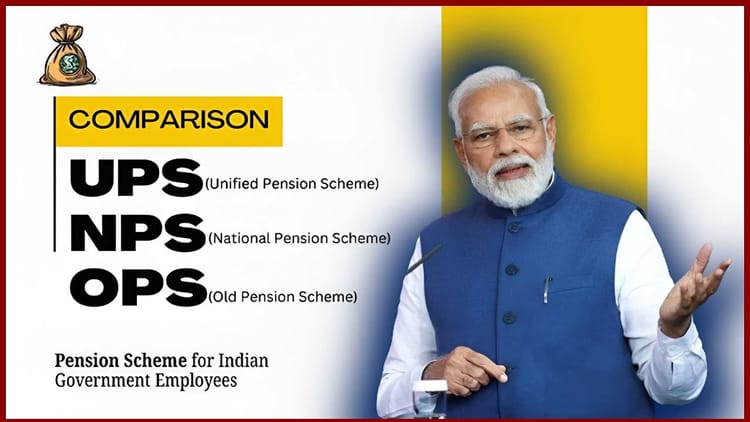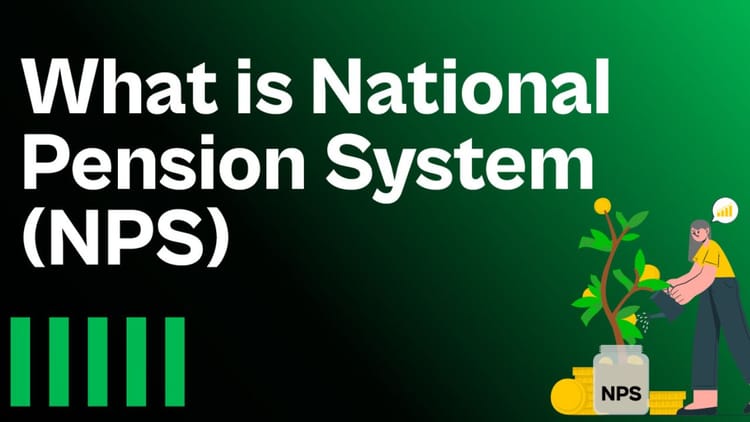Unified Pension Scheme (UPS): Eligibility & Benefits

The Unified Pension Scheme (UPS) is an initiative designed to ensure financial security for individuals after retirement. It integrates various pension schemes to provide a more streamlined and accessible framework for retirement planning in India. This article explores the eligibility criteria, benefits, returns, and important aspects of the UPS, helping you understand how it can support you in your post-retirement years.
What is the Unified Pension Scheme (UPS)?
- The Unified Pension Scheme is an overarching structure introduced to simplify and unify pension schemes in India. It aims to consolidate multiple pension plans under one umbrella to ensure easier access, management, and greater transparency. The UPS serves to provide income security to employees in the organized and unorganized sectors, helping them maintain a stable standard of living post-retirement.
- It simplifies the pension system by bringing together schemes like the National Pension Scheme (NPS), the Employee Provident Fund (EPF), and the Pradhan Mantri Shram Yogi Maan-Dhan (PMSYM), among others. This allows employees to choose their contributions while ensuring government-backed returns.
Eligibility Criteria for the Unified Pension Scheme (UPS):
One of the most crucial aspects of the Unified Pension Scheme is its eligibility requirements, which vary slightly depending on the specific program or pension plan involved. Below are the key eligibility factors that apply across the board:
Age Requirement:
- Generally, individuals must be between the ages of 18 and 65 years to enroll in UPS.
- Some sub-schemes may have a lower upper age limit, such as 40 years for the Pradhan Mantri Shram Yogi Maan-Dhan (PMSYM).
Employment Sector:
- Open to employees from both the organized and unorganized sectors.
- For government-backed schemes, government employees are automatically enrolled.
- Self-employed individuals and workers from the informal sector may also apply by contributing voluntarily.
Income Limitations:
- Certain sub-schemes, like PMSYM, require individuals to earn less than Rs. 15,000 per month to qualify.
Other Contributions:
- For those in the organized sector, contributions may already be part of EPF or NPS.
- Unorganized sector workers, such as farmers, laborers, and shop owners, must contribute manually.
Aadhaar Linkage:
- An Aadhaar-linked bank account is necessary to ensure seamless contributions and withdrawals.
Bank Account Requirement:
- Enrollees must have an active savings account in a recognized Indian bank.
Benefits of the Unified Pension Scheme (UPS)
The Unified Pension Scheme offers multiple benefits that cater to both individuals from the formal employment sector and those from the unorganized workforce. Below are some of the key advantages:
Guaranteed Pension:
- The UPS provides assured monthly pensions after retirement, ensuring that individuals have a steady source of income during their old age.
Flexibility in Contributions:
- Contributions can vary based on income and preferences. Individuals can make regular contributions during their working years to build a sizeable retirement corpus.
Government Co-contribution:
- For low-income individuals, such as those earning under Rs. 15,000 a month, the government offers co-contributions to encourage pension savings.
Tax Benefits:
- Contributions made under the UPS are eligible for tax deductions under Section 80C of the Income Tax Act, up to a limit of Rs. 1.5 lakh per annum.
- Additional tax benefits may be available under Section 80CCD (1B) for contributions made to NPS.
Portability:
- Individuals changing jobs between the public and private sectors, or moving from organized to unorganized work, can continue their pension contributions seamlessly without any disruption.
Inflation-Adjusted Payouts:
- The pension amounts are reviewed and adjusted periodically to account for inflation, ensuring that retirees maintain their purchasing power over time.
Risk Diversification:
- UPS provides multiple investment options under the NPS tier, allowing individuals to invest in equity, government bonds, and corporate debt.
- By diversifying risk, the scheme helps to optimize returns on investments while maintaining long-term stability.
Death and Disability Coverage:
- Some sub-schemes offer death and disability benefits, ensuring financial security for an individual’s family if they pass away or are unable to work.
Easy Access:
- The scheme is accessible to both salaried and self-employed individuals. For workers in the informal sector, enrolling in the UPS is simplified through local CSCs (Common Service Centres) and online portals.
Expected Returns from the Unified Pension Scheme (UPS)
The returns from UPS depend on several factors, such as the sub-scheme chosen, the amount contributed, the investment portfolio, and market performance. Below is a general outline of the returns under different components of the scheme:
National Pension Scheme (NPS):
- The NPS typically provides returns in the range of 8% to 10% annually, depending on the choice of investment portfolio (equity, government bonds, or corporate debt).
Employee Provident Fund (EPF):
- EPF offers guaranteed returns with an interest rate that is reviewed annually by the government. The current interest rate on EPF stands at around 8.15%.
Pradhan Mantri Shram Yogi Maan-Dhan (PMSYM):
- PMSYM offers a fixed monthly pension of Rs. 3,000 after the age of 60, provided the individual contributes between Rs. 55 and Rs. 200 per month, depending on their entry age.
Atal Pension Yojana (APY):
- Under the APY, individuals can receive pensions between Rs. 1,000 and Rs. 5,000 per month based on their contribution level. The return rate is fixed based on the pension amount chosen.
Market-Linked Returns:
- For individuals investing in the equity portfolio of the NPS, returns can fluctuate based on market performance but have historically outperformed fixed-income instruments.
Example:
- Let’s say you contributed Rs. 1,000 every month for 20 years, and the total accumulated amount at retirement is Rs. 5,00,000.
- If the pension formula involves dividing the total amount by a pension factor (e.g., 12), your monthly pension might be till Rs. 5,00,000 / 12 = Rs. 41,667.
The UPS ensures that pension contributions made over time yield substantial returns, creating a financial cushion for post-retirement life.
Here’s a table comparing the Unified Pension Scheme (UPS) and the National Pension Scheme (NPS) based on various parameters:
| Parameter | Unified Pension Scheme (UPS) | National Pension Scheme (NPS) |
|---|---|---|
| Objective | To unify and simplify various pension schemes under one umbrella for better accessibility and management. | To provide a structured pension plan for retirement savings with market-linked returns. |
| Eligibility | Open to both organized and unorganized sector employees; age between 18 and 65 years. | Open to all Indian citizens aged between 18 and 65 years, including government employees. |
| Contribution | Varies depending on the specific scheme; government co-contribution available for low-income individuals. | Contribution is flexible; individuals can choose their amount and frequency of contributions. |
| Government Support | Government provides co-contribution for certain schemes like PMSYM for low-income individuals. | No direct government co-contribution; returns are based on market performance. |
| Investment Options | Consolidates various schemes, including EPF, NPS, and PMSYM. Investment options are diverse depending on the scheme. | Offers a range of investment options including equity, government bonds, and corporate debt. |
| Returns | Returns depend on the specific scheme; some schemes offer fixed pensions, others have market-linked returns. | Market-linked returns; historically provides 8% to 10% returns depending on investment choices. |
| Pension Amount | Varies based on the scheme; PMSYM offers a fixed pension amount of ₹3,000 per month after age 60. | Pension amount depends on contributions and investment performance; can range from ₹1,000 to ₹5,000 or more. |
| Tax Benefits | Contributions are eligible for tax deductions under Section 80C; additional benefits under Section 80CCD (1B) for NPS contributions. | Contributions are eligible for tax deductions under Section 80C and additional benefits under Section 80CCD (1B). |
| Portability | High; individuals can continue contributions seamlessly across different schemes. | High; accounts can be managed and transferred across jobs and locations. |
| Withdrawals | Withdrawals depend on the specific scheme; some allow partial withdrawals under certain conditions. | Partial withdrawals are allowed for specific purposes like medical emergencies, education, or home purchase. |
| Inflation Adjustment | Some schemes adjust pensions for inflation, while others offer fixed pensions. | Returns and pension payouts may be adjusted based on market performance and inflation. |
| Death and Disability Coverage | Available in some schemes; benefits vary. | Includes provisions for death and disability benefits under NPS Tier I account. |
| Ease of Access | Accessible through various government portals, banks, and Common Service Centres. | Accessible online through the NPS portal, as well as through various points of presence (PoPs). |
This table outlines the primary differences between the Unified Pension Scheme and the National Pension Scheme, helping you understand their unique features and benefits.
Conclusion:
- The Unified Pension Scheme (UPS) is a well-structured solution for individuals seeking a secure and stable income post-retirement. Whether you are employed in the organized sector or a worker in the unorganized sector, the UPS provides a range of benefits that ensure your financial well-being in your later years. By offering flexibility in contributions, government backing, tax incentives, and inflation-adjusted payouts, UPS is a comprehensive solution for retirement planning in India.
FAQs about Unified Pension Scheme (UPS):
What is the Unified Pension Scheme (UPS)?
- The UPS is a retirement savings scheme that consolidates several existing pension schemes in India, providing individuals with a unified framework for contributing toward their post-retirement financial security.
Who is eligible for the UPS?
- Individuals between the ages of 18 and 65 from both the organized and unorganized sectors are eligible. Additional conditions such as income limitations and sector-specific criteria may apply.
How does the government contribute to the UPS?
- In certain schemes like PMSYM, the government provides co-contributions to individuals earning under Rs. 15,000 a month to encourage pension savings.
What are the tax benefits of contributing to UPS?
- Contributions to UPS are eligible for tax deductions under Section 80C of the Income Tax Act, up to a maximum of Rs. 1.5 lakh per annum. Contributions to NPS offer additional deductions under Section 80CCD (1B).
Can I withdraw my contributions before retirement?
- Some pension schemes like the NPS allow partial withdrawals for specific reasons such as medical emergencies, education, or the purchase of a home. EPF also allows withdrawals under specific conditions.
How much pension will I receive from UPS?
- The amount of pension depends on the sub-scheme under which you are enrolled, your contributions, and the returns generated. For example, under PMSYM, a fixed monthly pension of Rs. 3,000 is provided after retirement, whereas NPS provides market-linked returns.
Can I change my contribution amount?
- Yes, the UPS allows flexibility in contributions. You can increase or decrease your contributions based on your financial situation.
How do I apply for UPS?
- Individuals can apply for UPS through government portals, banks, post offices, and Common Service Centres (CSCs) depending on the scheme.
Is UPS safe?
- Yes, the UPS is government-backed, ensuring a certain level of safety for your contributions. Depending on the portfolio chosen, particularly in NPS, you may also gain higher returns from market-linked investments.
We hope that you like this content and for more such content Please follow us on our social site and YouTube and subscribe to our website.
Manage your business cash flows and payable/receivables using our Bahi Khata App




Comments ()